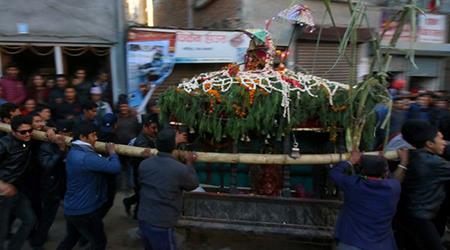Yomari Punhi is one of the festivals dear to the Newas of Nepal, mainly celebrated in the Kathmandu Valley. It falls on the full moon of the Tihar festival month, which is normally in December or January according to the Nepal Sambat calendar, a lunar calendar used by the Newars. Yomari Punhi signifies the end of the harvesting season and is especially relevant for the Newar people, who consider it as an occasion for thanksgiving for the agricultural gains achieved with appropriate rituals.

Historical and Cultural Background:
Origin and Meaning:
The word "Yomari" is derived from two words in Newar: "Yoma," which means "fig," and "Ari," meaning "dumpling" or "cake." This is because the dumpling is fig-shaped. It is also called "Yomari Punhi," where the word "Punhi" in the Newar language means "full moon.".
The tradition of offering yomari is believed to have its roots in agriculture whereby the Newar people would use the festival to thank Annapurna, the goddess of food and grain. The rice harvest season is over and means a prosperous future in front with a good yield in the coming year.
Agricultural Importance:
Yomari Punhi coincides with the winter harvest and therefore is related to the resting and rejuvenation period of farmers after finishing the harvesting. This is when, other than rice, offerings are made to the deities as a sign of winter's arrival in the Newar community. This is, therefore, considered high time for the families in the countryside and farmers to be joyful owing to the harvest plenty and pray for such a good crop in the next seasons too.
Celebration and Rituals:
To offer it to the gods: The Newars prepare and offer Yomari to the gods on this day, mainly to Annapurna, who blesses the community with food and grain. In some communities, offerings are made in the temples, and families often perform rituals at home, invoking deities for prosperity, good health, and well-being.
Family Gathering: Yomari Punhi is the time when the family, especially in the Kathmandu Valley, comes together to prepare and share yomari. All these make community and family bonds strong. After the religious rituals are over, yomari is enjoyed with thankfulness and togetherness.
Yomari as Sacred Food:
More than food, yomari is symbolic-an offering, mainly preparation of rice flour dough with different fillings such as molasses (chaku), sesame seeds, lentils, and sometimes coconut or jaggery. These fillings are symbolic of prosperity, sweetness, and fertility. The special shape of yomari symbolizes the fig fruit, which was sacred and believed to hold blessings for health, good wealth, and fortune.
Community Celebrations:
Traditional Songs and Rituals: Children in some places go around singing traditional songs at the doorsteps, spreading joy and merriment of the occasion everywhere. People share yomari with neighbors and friends and keep the spirit alive through communal feelings in these activities.
The full moon of this month falls as Jyapu Day in some areas of Kathmandu Valley. It means on that day, both celebrations coincide, dedicated to the laborers who are involved in agricultural work. Their service is honored to pay thanks for the different kinds of food provided by them.
Full moon significance:
According to the tradition, the full moon of the festival gives signals of light and prosperity. Its light is considered to bring prosperity, and people accept that light brings blessings into their lives.
Yomari Punhi: Symbols it Embodies
Fertility and Prosperity: Its fig-like shape and an important aspect of fertility signal the yomari symbol. The consumption of certain things invites the blessings of increased wealth, health, and abundance into the house.
Thanksgiving: It is a festival of gratitude for the good yield of crops, and the time when the gods are appeased and prayed to for their favors in the coming harvest season.
Yomari Preparation:
Dough: Rice flour mixed with water and a pinch of salt is well-kneaded into a smooth dough.
Fillings: The most common is a mixture of molasses (chaku) with sesame seeds. Sometimes used are lentils or coconut.
Steaming: Once filled, dough assumes a fig-like shape and then steams in an old traditional basket
Serving: First, they would give yomari to the gods, after which they would eat them, and according to their beliefs, this brought fortune among their family members.
Modern-day Celebrations
Although traditional customs and religious practices remain central to the festival, the celebration of Yomari Punhi is increasingly a community event in urban areas, particularly among the younger generation. It often includes modern variations of yomari with various fillings, such as chocolate, cheese, or even fruits.
In other words, it is a festival of yomari that amalgamates the theme of harvest and prosperity together with gratitude for the good things in one's life along with cultural expression by the sharing of delicious yomari. It remains a significant factor in Newa's identity within Nepalese heritage.






0 Comments